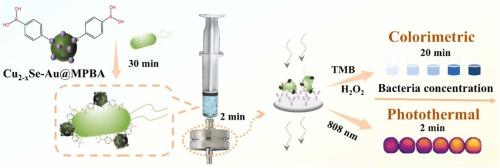Colorimetric and photothermal dual-mode vertical flow assay for sensitive detection of Escherichia coli O157:H7 based on 4-mercaptophenylboronic acid-functionalized Cu2-xSe-Au nanozyme
IF 3.7
1区 化学
Q1 CHEMISTRY, ANALYTICAL
引用次数: 0
Abstract
Rapid detection of bacteria and sensitive detection of bacteria are like two sides of a coin, making it difficult to achieve both at the same time. This study designed a colorimetric-photothermal dual-mode vertical flow assay based on 4-mercaptophenylboronic acid (MPBA)-functionalized Cu2-xSe-Au nanozyme (Cu2-xSe-Au@MPBA). The Cu2-xSe-Au@MPBA probes were synthesized through in situ reduction. These probes can bind with target bacteria and the antibodies immobilized on the filter membrane, thereby forming a "nanomaterial-bacteria-antibody" sandwich structure. The dual-mode signals come from the peroxidase-like activity and photothermal properties of the Cu2-xSe-Au@MPBA nanozyme. Both colorimetric and photothermal modes can be completed in 60 min. This assay demonstrates low detection limits of 26.34 CFU mL⁻¹ in colorimetric mode and 1.91 CFU mL⁻¹ in photothermal mode. Real sample analysis by this assay showed excellent anti-interference capability and reliable recovery rates, which demonstrate a significant potential for applications in food safety monitoring and bioanalysis.

基于4-巯基苯硼酸官能化Cu2-xSe-Au纳米酶的比色法和光热双模垂直流灵敏检测大肠杆菌O157:H7
细菌的快速检测和细菌的敏感检测就像一个硬币的两面,很难同时实现两者。本研究设计了一种基于4-巯基苯硼酸(MPBA)功能化Cu2-xSe-Au纳米酶(Cu2-xSe-Au@MPBA)的比色-光热双模式垂直流分析方法。通过原位还原法制备Cu2-xSe-Au@MPBA探针。这些探针可以与目标细菌和固定在过滤膜上的抗体结合,从而形成“纳米材料-细菌-抗体”的三明治结构。双模信号来自Cu2-xSe-Au@MPBA纳米酶的过氧化物酶样活性和光热性质。比色和光热模式都可以在60 min内完成。该分析显示,在比色模式下的检测限为26.34 CFU mL⁻¹ ,在光热模式下的检测限为1.91 CFU mL⁻¹ 。该方法在实际样品分析中具有良好的抗干扰能力和可靠的回收率,在食品安全监测和生物分析中具有重要的应用潜力。
本文章由计算机程序翻译,如有差异,请以英文原文为准。
求助全文
约1分钟内获得全文
求助全文
来源期刊

Sensors and Actuators B: Chemical
工程技术-电化学
CiteScore
14.60
自引率
11.90%
发文量
1776
审稿时长
3.2 months
期刊介绍:
Sensors & Actuators, B: Chemical is an international journal focused on the research and development of chemical transducers. It covers chemical sensors and biosensors, chemical actuators, and analytical microsystems. The journal is interdisciplinary, aiming to publish original works showcasing substantial advancements beyond the current state of the art in these fields, with practical applicability to solving meaningful analytical problems. Review articles are accepted by invitation from an Editor of the journal.
 求助内容:
求助内容: 应助结果提醒方式:
应助结果提醒方式:


